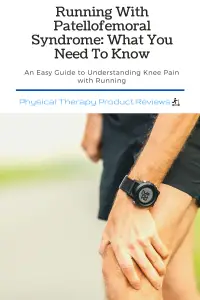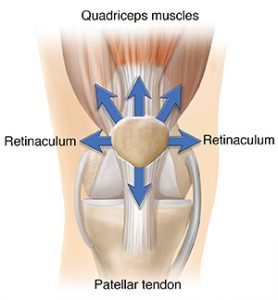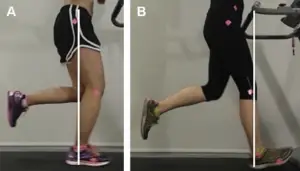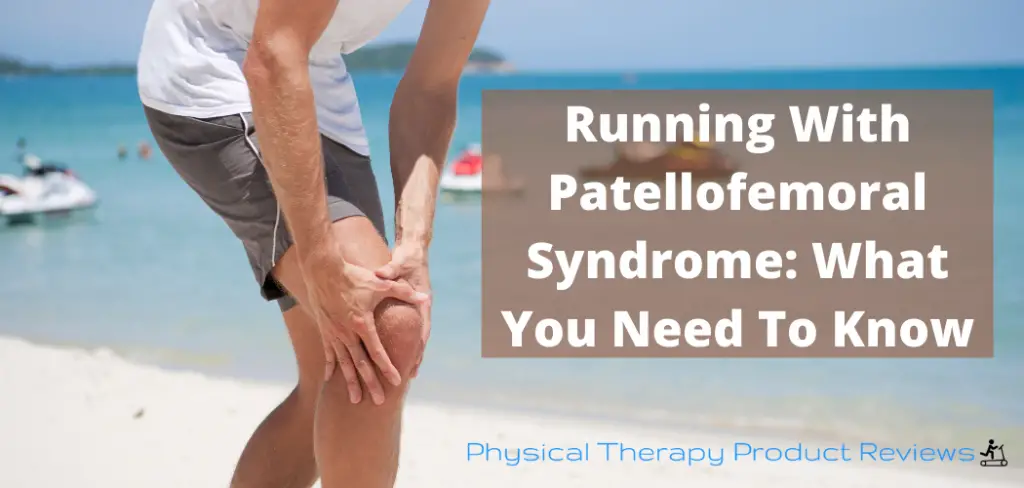Running with Patellofemoral Pain Syndrome (PFPS) can be difficult and painful. It is important to understand how running causes pain, why patellofemoral pain syndrome might cause running-related pain, and what you can do about it.
Patellofemoral pain syndrome is a condition in which the kneecap becomes overloaded. This can be due to the patella not tracking correctly over the Femur. This causes irritation of tissues around the patella (kneecap), leading to inflammation and sometimes fluid buildup in this area of the joint capsule.
The result is increased pressure on nerves that surround this area of the joint, causing more intense sensations of pain than usual when running or kneeling down for long periods of time.
Does Patellofemoral Syndrome Cause Pain with Running?
 Yes, Patellofemoral Pain Syndrome can cause running-related pain. This is due to the fact that running puts a lot of demand on the patella and surrounding tissues. However, this does not mean you should stop running forever if you have patellofemoral syndrome!
Yes, Patellofemoral Pain Syndrome can cause running-related pain. This is due to the fact that running puts a lot of demand on the patella and surrounding tissues. However, this does not mean you should stop running forever if you have patellofemoral syndrome!
It simply means that it’s important to understand how running affects your body when dealing with patellofemoral pain syndrome.
There are ways that you modify and increase strength in the short term so that you can run pain-free in the future.
What is Patellofemoral Pain Syndrome?
Yes, Patellofemoral Pain Syndrome can cause running-related pain. This is due to the fact that running puts a lot of demand on the patella and surrounding tissues. However, this does not mean you should stop running forever if you have patellofemoral syndrome!
It simply means that it’s important to understand how running affects your body when dealing with patellofemoral pain syndrome.
There are ways that you modify and increase strength in the short term so that you can run pain-free in the future.

referenced from:
11289_Mech_1203
Causes of Knee Pain with Running
Running causes increased pressure on the kneecap, leading to irritation of tissues around it and more intense sensations of pain than usual. This is because running has a greater impact on the patella due to higher amounts of forces without the body being able to support those forces.
During running, the kneecap has to withstand forces 7-11x someone’s body weight. If there is an alignment issue, strength deficit, or abnormal tracking in the knee it doesn’t take long for those forces to become painful.
This pain is most noted during running-specific tasks such as running down hills, running upstairs or running at a higher intensity, squatting, and kneeling for long periods of time.
Common Running Mechanics Mistakes with Patellofemoral Pain Syndrome
There are many different abnormalities that may cause PFPS with running, however, two of the most common mistakes that we see are overstriding and running with a backward trunk lean.
Overstriding
This is by far the most common mistake we see during a running analysis for people with patellofemoral pain syndrome.
Overstriding is when the foot contacts the ground in front of the center of gravity. By landing with the foot outstretched in front of the body it produces a high amount of braking forces through the leg and knee cap. These forces on the kneecap increase the further the foot lands in front of the body.

The foot should land underneath the body and within the center of gravity.
Backward Trunk Lean
Leaning backward is often also seen during overstriding and is not always an exclusive issue. When running, there should be a forward lean that comes from the ankles.
If there is an upright or a posterior trunk lean the legs have to reach forward in front of the body during each step. This also causes increased forces into the patella and can lead to patellofemoral pain syndrome.
This can be an indication of weakness in the glutes and thighs and a strengthening program in addition to changing your running form is recommended at this point.
How to Change Running Mechanics for Patellofemoral Pain Syndrome
Whether your running mechanics involve overstriding, posterior trunk lean, both, or other issues with running there are a few simple ways that you can improve your form and fix many of the issues.
Increase Running Cadence
This is the most common and recommended way to fix most running issues. The recommended running cadence is between 170-180 steps per minute but your optimal running cadence may be slightly more or less.
The increased cadence isn’t necessarily the magic fix, but the physical changes that occur to reach that cadence are helpful.
By running at an increased cadence there is less contact time with the ground. Less contact time means that the forces in the knee catch reach high levels.
Try downloading running mixes off of Spotify with beats at 170-180 steps per minute or you can download a metronome app and use it to find the best cadence.
Run Into the Wind
There are a couple of different terms for this but the goal is to get people to lean forward at the ankles while running.
Leaning backward with the trunk puts more pressure on the knee cap.
To practice this, stand a large step away from a wall. Lean forward and place both hands on the wall. Run in place and feel the angle that your body is in. Try to replicate that position when running upright.
If you are running outside then try to lean forward as if you are running into a stiff wind.
You can also run up a hill as this also causes your body to lean forward at the ankles and helps achieves the optimal running position.
Does Foot Strike Position Matter with Patellofemoral Pain
Yes, it can matter. Runners with a heel strike tend to have higher bouts of anterior knee pain.
This is due to the fact the heel strikers may overstride causing breaking forces at landing. This increases pressure in the patella.
We don’t try to change the landing pattern much between heel strike, midfoot, or forefoot strike.
We care more about where the contact with the ground is in relation to the center of the body’s gravity.
Pro Tip: Instead of trying to change landing patterns simply try to increase cadence, emphasize a higher knee drive, and emphasize the foot to hit underneath your center of gravity.
Tips to Decrease Pain During Running With Patellofemoral Syndrome
If you have pain during running it does not mean that you have to completely stop running. It means that you do need to change some things to avoid further aggravating the knee. If possible we want to keep you running with a few changes.
Make a Few Running Mechanics changes
You may simply need to change running biomechanics. This can include running on softer surfaces, increasing your cadence and foot strike pattern (avoiding heel strikes), or making sure that the initial contact is within your center of gravity.
In addition, try running with a slight forward trunk lean. You can do this by pretending like you’re running into a stiff wind or like you are running uphill.
Try Different Running Shoes
This may include running in a more cushioned shoe, running with your current running shoes and adding orthotics, or completely switching to another running shoe style.
There is research that supports rotating through different pairs of shoes each day of the week. This changes when the load is during each day of running helps avoid overuse injury.
Run with a Knee Brace for Patellofemoral Pain Syndrome
There is research to support running with a patella brace for those who have anterior knee pain running.
For running, you want to pick a knee brace that can help support the knee and change how pressure is absorbed in the knee.
You won’t have to wear the knee brace forever, but plan on wearing it for 3-4 weeks until the knee calms down and pain levels reduce.
You can see our in-depth review of patella-tracking knee braces here to find the best one for you.
Try Taping the Knee for Running
You can tape the knee and this will help it control the forces in the knee while running. This may not cure anything but can help make running more tolerable.
This is typically done with kinesiotape because it’s easy to do to yourself and the tape is fairly inexpensive.
Here is a helpful way to take your knee with kinesiotape for running.
Try Wearing Insoles to Decrease Anterior Knee Pain
This is something that we will have people try in the short term. If you have knee cap pain with running we may have you try using a high arch support insole in your shoes for 6-weeks.
The goal of this is to simply change where the forces in the legs are located when running to allow for the knee cap to calm back down.
This does not mean that you need to wear insoles in your shoes forever but is a great option to reduce pain in the short term and still allow you to run.
It is still important that you focus on proper running form and improving quadriceps and hip strength.
These are our current favorite insoles to try if you have pain in the knee cap with running.
Conclusion
There is hope if you have pain with patellofemoral pain syndrome and running. Some of it is simply changing running biomechanics and using different types of braces, insoles, or taping the knee to decrease pain during running.
In addition, there are other things you can do including strengthening your quads and hip muscles which reduces pressure in the knee.
If running with patellofemoral syndrome does not work, simply switch to another form of exercise. Just because running doesn’t work for you now, there are other forms of cardio that will help decrease pain in the knees.
Other Great Rehab Related Articles
How to Stay Active After Cervical Fractures: Expert Tips and Advice
Dealing with Painful Stairs After Ankle Replacement Surgery
Walking After a Total Ankle Replacement: Tips for a Successful Recovery
Exercises While Non-Weight Bearing After Ankle Replacement: Elevation, AROM, Leg Raises, and More
Ankle Pain with Stairs: Causes and Home Treatment Options
5 Common Mistakes You’re Making After an Ankle Sprain
Disclaimer: The information provided in this post is for educational purposes only. This is not a substitute for a medical appointment. Please refer to your physician before starting any exercise program.







